On Wednesday we had the pleasure of taking a tour of parts of the Vavilov Institute. The first stop on our tour was the Herbarium. An herbarium is a collection of preserved samples of plants or plant parts, usually pressed on sheets of paper, for scientists and researchers to view. The herbarium at the Vavilov Institute is home to over 200,000 such samples, collected by Vavilov himself and other scientists on collection missions throughout the world. It was once one of the preeminent herbariums in the world, but now the largest herbariums in France and England house over seven million specimens!
We were very excited to see the herbarium, but also a bit surprised at its condition. Everything was very clean and well organized, but it seemed that funds were deemed to be more useful elsewhere, as the lights were off and the room was lit through the open curtains only (this could be better for the specimens). There was no climate control, and the cabinets and boxes used to store the specimens were quite antique looking. Many aspects of the Vavilov Institute seem to be straight from another time, and the herbarium was no exception.
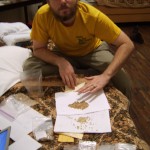
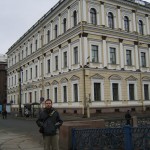
Left: Preparing seeds to give to VIR. Right: The Vavilov Institute.
There were a few people working in the room, examining specimens at their leisure. The coordinator took a few minutes to show us some samples that are kept out as examples of the layout of different types of plants. We viewed samples of a grass and a tree, and observed how they were filed according to species in boxes stacked in row after row of tall wood cherry wood cabinets. One of the samples had the signiture of Vavilov on it — this was a sample that he had actually collected! After sufficient oohs and aahs, we walked down to the office of one of the scientists.
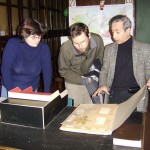
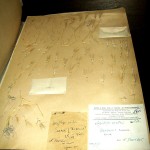
Left: Sergey showing us the the Herbarium collection. Right: A specimen collected by N.I. Vavilov in the 1920’s.
We were quite happy to meet the Director of Legumes, Dr. Margarita Vishnyakova. In her office we found petrie dishes with examples of the different species of beans and peas, and a large case filled with different fava bean (Vicia faba) varieties. On her wall were two mosaics made from beans, and on shelves around were giant pods from leguminous trees and branches from different leguminous plants.
Dr. Vishnyakova showed us a presentation she had developed on her computer, detailing the work they do at the department and showing photos of everything from sweet peas to green beans. There was also a flow chart showing who does what in the department, with each scientist in charge of one or several species for collection and research, and research assistants beneath them.
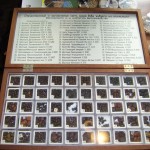
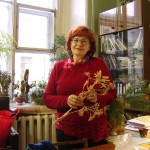
Left: Desplay of some of the beans in the collection. Right: Dr. Vishnyakova the “King” of Legumes.
We had the great privilege of presenting to Dr. Vishnyakova the legumes that we had brought with us from Oregon and some we had collected along the way, in the form of Pisum sativum (peas, including five varieties from Latvia and two developed by Dr. Alan Kapular), Phaseolus vulgaris (four common beans), Phaseolus coccineus (one runner bean), Phaseolus acutifolius (one tepary bean). She especially liked the Alice Sunshine bean originally developed by the late Robert Lubitz, a member of the Seed Saver’s Exchange, and gifted to us by Dr. Alan Kapular.
Along with the beans we had brought with us from Oregon, we also presented a bean we had purchased in a Russian shop that was labeled “Pinto,” though they looked unlike any pinto bean we had ever seen, shaped like a small kidney bean but colored a deep red with speckles like a Portugese Barlotto type. The package indicated they were from Canada. Dr. Vishnyakova giggled a bit and told us that she, too, collects accessions from shops sometimes, and that last year two new accessions of American peas were made in this way.
After we had thanked her for her time and returned to Sergey’s office, Marina Burlyaeva, a scientist of the Legume Department, Curator of Lathyrus (including flowering sweet peas) and Vigna (including adzuki beans and black eyed peas) came to speak with us. As a Curator, it is her responsibility to see that the Institute has representatives of each species in those two genuses. She was unhappy to inform us that there was a giant hole in the collection, in the shape of Lathyrus notolathyrus — a pea mostly native to South America and possibly wild in the United States.
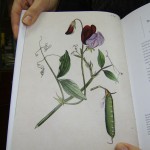
Example of the easily recognizable lathyrus genus (Lathyrus odoratus).
Ms. Burlyaeva asked us if we could go on a collection mission for samples of this species. We were honored at the request, and excitedly imagined taking our Seed Ambassadorizing one step further — on a collection mission for the Vavilov Institute! We were both very glad that we had seen samples of collections in the herbarium, so we could include properly mounted samples of the plants with our shipment of seeds. We told her that it might be a while before we could begin our mission, if we can do it at all, well aware that we are not trained botanists and do not exactly live in South America. She laughed and said all the same, it will be much more likely for us to do it than for her to go on a collection mission at this point in time. One more thing due, of course, to the Institute’s lack of funding.
Leave a Reply